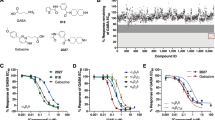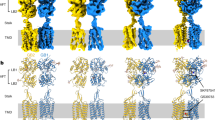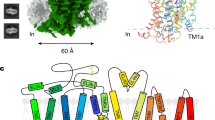Abstract
COMPOUNDS which mimic the activity of the inhibitory neurotransmitter γ-aminobutyric acid (GABA) on postsynaptic receptors are of particular pharmacological interest as possible therapeutic agents in human neurological disorders and as molecular probes with which to study different types of GABA receptors. The GABA molecule has considerable flexibility with free rotation around all three carbon–carbon bonds as indicated in Fig. 1. This conformational mobility is reduced in GABA analogues such as trans-4-aminocrotonic acid1 and muscimol2, which are potent GABA agonists at bicuculline-sensitive receptors on spinal neurones of the cat. The conformational mobility of such compounds can be reduced still further by incorporating the amino function in a ring structure. This has led to a new class of GABA agonist described here, based on l,2,3,6-tetrahydropyridine-4-carboxylic acid (isoguvacine) and the related bicyclic isoxazole 4,5,6,7-tetra-hydroisoxazolo[5,4-c]pyridin-3-ol (THIP) (Fig. 1). Isoguvacine represents a semi-rigid analogue of trans-4-aminocrotonic acid in a folded conformation. THIP, a folded analogue of muscimol, is even more rigid as the ‘masked’ carboxyl group (the 3-isoxazolo moiety) is fixed in the general plane of the molecule. The action of these compounds as GABA agonists provides indirect evidence that GABA interacts with bicuculline-sensitive postsynaptic receptors in the cat spinal cord in a partially extended and almost planar conformation.
This is a preview of subscription content, access via your institution
Access options
Subscribe to this journal
Receive 51 print issues and online access
$199.00 per year
only $3.90 per issue
Buy this article
- Purchase on Springer Link
- Instant access to full article PDF
Prices may be subject to local taxes which are calculated during checkout
Similar content being viewed by others
References
Johnston, G. A. R., Curtis, D. R., Beart, P. M., Game, C. J. A., McCulloch, R. M. & Twitchin, B. J. Neurochem. 24, 157–160 (1975).
Curtis, D. R., Duggan, A. W., Felix, D. & Johnston, G. A. R. Brain Res. 32, 69–96 (1971).
Beart, P. M., Johnston, G. A. R. & Uhr, M. L. J. Neurochem. 19, 1855–1861 (1972).
Beart, P. M., Uhr, M. L. & Johnston, G. A. R. J. Neurochem. 19, 1849–1854 (1972).
Krogsgaard-Larsen, P. & Christensen, S. B. Acta chem. scand. B 30, 281–282 (1976).
Johnston, G. A. R. et al. Nature new Biol. 240, 219–220 (1972).
Krogsgaard-Larsen, P. & Johnston, G. A. R. J. Neurochem. 25, 797–802 (1975).
Johnston, G. A. R., Krogsgaard-Larsen, P. & Stephanson, A. Nature, 258, 627–628 (1975).
Lodge, D., Johnston, G. A. R., Curtis, D. R. & Brand, S. J. Brain Res. (in the press).
Krogsgaard-Larsen, P., Johnston, G. A. R., Curtis, D. R., Game, C. J. A. & McCulloch, R. M. J. Neurochem. 25, 803–809 (1975).
Author information
Authors and Affiliations
Rights and permissions
About this article
Cite this article
KROGSGAARD-LARSEN, P., JOHNSTON, G., LODGE, D. et al. A new class of GABA agonist. Nature 268, 53–55 (1977). https://doi.org/10.1038/268053a0
Received:
Accepted:
Published:
Issue Date:
DOI: https://doi.org/10.1038/268053a0
This article is cited by
-
In silico screening of GABA aminotransferase inhibitors from the constituents of Valeriana officinalis by molecular docking and molecular dynamics simulation study
Journal of Molecular Modeling (2020)
-
Douleur et thermorégulation. La région bulbaire rostroventrale
Douleur et Analgésie (2016)
-
Muscimol as an Ionotropic GABA Receptor Agonist
Neurochemical Research (2014)
-
The GABA Synapse as a Target for Antiepileptic Drugs: A Historical Overview Focused on GABA Transporters
Neurochemical Research (2014)
-
Probing the Orthosteric Binding Site of GABAA Receptors with Heterocyclic GABA Carboxylic Acid Bioisosteres
Neurochemical Research (2014)
Comments
By submitting a comment you agree to abide by our Terms and Community Guidelines. If you find something abusive or that does not comply with our terms or guidelines please flag it as inappropriate.



